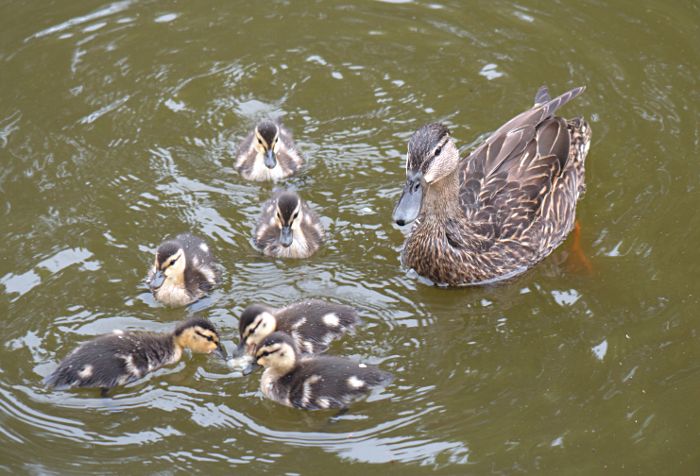Tuesday, May 4th, 2010
The yellow summer squash, from a different seed packet than the ones that were failing before, is blooming. The leaves have white along the veins, which we’re guessing is bad, but on the whole they have perhaps some hope.
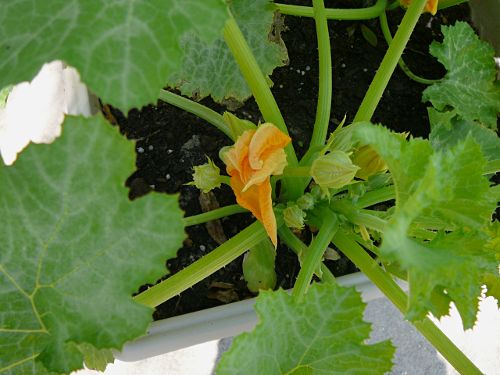
There are a lots of fruits on the peppers and tomatoes, although all are still fairly small, compact plants. There is a stealthy bug eating our tomatoes when they first start turning from dark green.

The basil is doing well enough to only look a bit thin after collecting two cups for pesto. One of our thymes is flowering, and so are the chives.
Monday, May 3rd, 2010
Update: A few days old now (May 7), but this Bloomberg story (via Ritholtz) has more information than most stories I’ve read.
All of the fisher-people, tourist industries and environmentalists, and everyone else who lives around the Gulf, are watching anxiously. “An estimated 5,000 barrels (over 200,000 gallons) of crude oil is pouring into the Gulf of Mexico every day” (6) “Eight robotic submarines were working around the clock to fix the well’s blowout preventer — a “fail safe” that nonetheless was unable to prevent the spill” (3) “The best-case scenario is that oil will continue gushing into the Gulf of Mexico for another week. British oil company BP is working to deploy a system that would siphon away crude from the blown-out well a mile underwater, but it will take six to eight days to get it in place.” (2) ‘Such an operation, he [BP CEO Tony Hayward] said, had “never been done at 5,000 feet.”‘ (3)
Maps from NOAA tracking the oil slick are here.
‘”I’ve been in Pensacola and I am very, very concerned about this filth in the Gulf of Mexico,” Florida Gov. Charlie Crist said at a weekend fundraiser for his U.S. Senate campaign.’ (2) I’m just struck by calling it filth when Crist has apparently gone back and forth on drilling. In 2008, “Florida’s once-solid bipartisan opposition to drilling in the Gulf of Mexico shattered Tuesday when Gov. Charlie Crist reversed course and said the state may have to allow drilling to help lower gasoline prices.” (5) Back in the present and on the other coast, “California Gov. Arnold Schwarzenegger reversed Monday his position on expanding drilling off of California’s coast in the wake of the massive oil spill in the Gulf of Mexico.” (1)
“The spill now covers thousands of square miles and is getting close to the Loop Current, which speeds south through the Gulf and into the Florida Keys. It then hits the Gulf Stream, which could then drive the oil north along Florida’s Atlantic Coast.” (4)
“Over the weekend, Alabama Attorney General Troy King said he had told BP representatives to stop circulating settlement agreements among coastal residents that reportedly offered payments of up to $5,000 in exchange for not suing the company.” (3) “A law passed in response to the 1989 Exxon Valdez spill in Alaska makes BP responsible for cleanup costs. But the law sets a $75 million limit on other kinds of damages.” (7)
‘”Would it be possible to just go out there and bomb the hell out of it?” said Kenny Wilder, 67, of Navarre, just east of Pensacola. A man behind him yelled, “Napalm it.”‘ (4)
1. NPR, 2. NPR, 3. NPR, 4. MSNBC”, 5. Palm Beach Post, 6. Boston Globe Big Picture, 7. AP
Sunday, April 11th, 2010
Maybe it’s just us, since we seem to have this complaint about a lot of places, but really, where’s the parking? Especially when driving the GTO, hanging off the side of the road isn’t appealing. And while you’re at it, make a bike/pedestrian lane. There should be space for people to stop, take pictures, point out creatures that they’ve misidentified, without blocking the road. We did appreciate the excellent signage for finding the entrance to the park, and the map in the brochure from the ranger station was much more readable than those offered at some other parks.
The canopy walk is an 85′ suspension bridge between two towers in the middle of the forest. The later tower continues above the bridge to a hight of 74′. I’m guessing that doesn’t count the extra foot or two for the lightning rod. This structure is by far the tallest object anywhere for miles and there are no hills in this part of Florida. Obviously the view is great, but half of the experience is the swaying, of the bridge from people walking, and of the tower from the wind.
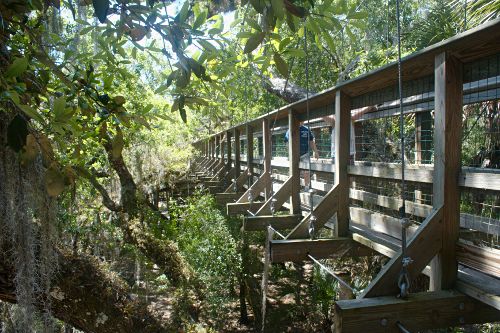
In the heat of midday there weren’t many birds near the birdwalk. There were fishing spiders, baby fish, a snake that I didn’t get to see, the croaking of what was probably a few bull frogs, and lots of dragonflies. My best guess of this species is Carolina Saddlebags. This is an difficult perspective to see its wings properly, but there are red-brown bands on its rear wings near its body.
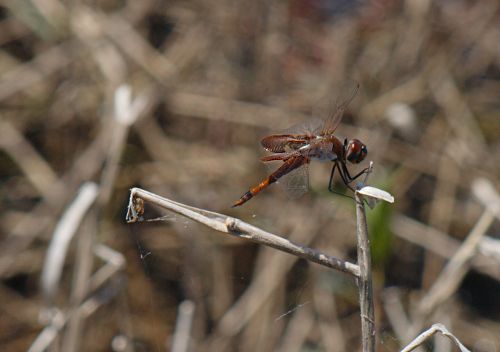
This quill leaf bromeliad (listed as endangered because of its destruction by the invasive Mexican weevil) was at the turning around point of our walk because the mosquitoes finally found us. There is a lot of swampy area in this park, and I’m surprised we made it as long as we did mosquito free. We saw a few blooming swamp irises (Anglepod Blue Flag?), but my hand-holding in the shade didn’t turn out so well.
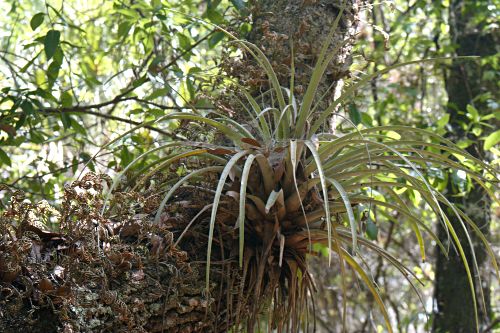
Saturday, April 10th, 2010
I was thinking I had posted this picture, but Mike informed me that he was still waiting for it. This is a fishing spider, possibly Dolomedes triton, at Alligator Lake in Lake City in September 2009. We saw another fishing spider today, but I didn’t get nearly as good a picture of it this time. They can walk along the water, like water striders, and sense motion transmitted along the surface of of water to find prey instead of along the strands of webs.
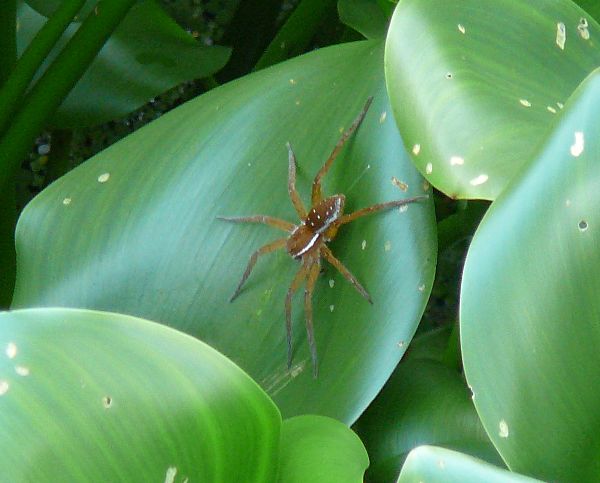
For good measure, here are the other pictures that I never posted from that trip. This is a phaon crescent.
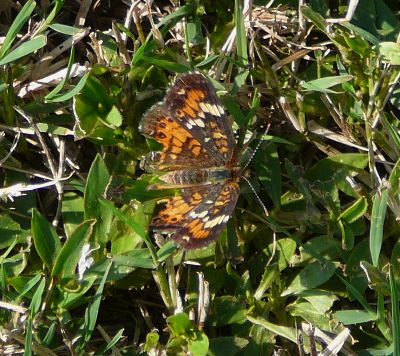
None of the froggies in our Audubon guide look like this little guy. [Update: We now suspect that this is a baby bullfrog]
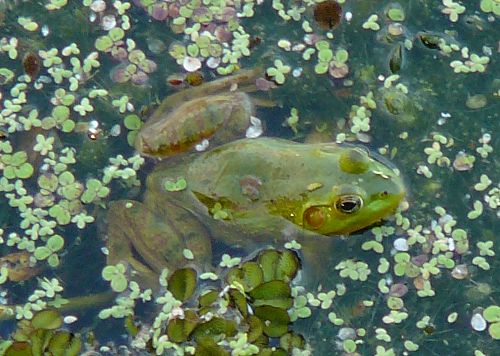
Tuesday, April 6th, 2010
On Saturday, Mike counted four ducklings. On Sunday the neighbors and Mike saw a water moccasin. We’ve repotted the tomatoes twice now, and several of the herbs have perked up since fertilizing a few weeks ago.
We put up a bird feeder on a metal pole over the weekend. It has a shroud on a spring that will lower and cover the openings to the seed if a heavy enough animal rests on the feeder. The idea is to keep the squirrels, which are still occasionally digging around our plants, away from the bird seed. So far so good. We saw what was probably a male red winged blackbird at the feeder, and Mike saw a Cardinal underneath it.
Tuesday, March 30th, 2010
On Saturday and Sunday there were six. On Monday I counted five. I’ve not seen the little ones today, though the male paddled by while we were cooking super yummy kabobs.
